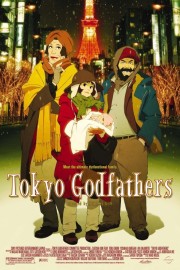Tokyo Godfathers
In a career cut short by cancer, the anime director, Satoshi Kon, directed four features, never repeating himself in style or story. Although his first feature, the stunning thriller, “Perfect Blue,” traffics in many of the same things that anime is known for in the States (namely, ultraviolence and unnerving sexuality), Kon quickly moved on to more intriguing subjects and stories with his next feature, the sweeping, sensational “Millennium Actress.” Though told in a way that could only be done in animation, its story of an actress looking back on her life and career for a documentary crew is as natural and beautiful a human story that’s ever been told on film.
With his third film, “Tokyo Godfathers,” Kon moved even further from the traditional ideas of what anime should be. The film is inspired by John Ford’s 1948 film, “3 Godfathers,” which starred John Wayne as one of three outlaws who come across a dying mother and her newly-born child, and promise to take the child safely across the desert. Working with writer Keiko Nobumoto, Kon transplants that story to modern day Tokyo, this time with three homeless people– the alcoholic Gin, the drag queen Hana, and the young woman Miyuki –who stumble upon an abandoned child on Christmas Eve. I’ve never seen the Ford film, but I’d be surprised if the themes were that different between the two films, since both center around social outcasts put in a situation that is alien to their natures.
At the time my friends Ron and Dave and I saw the film in theatres in 2004, I found the film to be a bit too much of a downer to be genuinely entertaining, but watching it again, I find the tone more joyful than the story would normally allow for. The comedy is humane and comes naturally out of the situations and characters rather than just being an extended sitcom like “Three Men and a Baby” (come on, I had to mention it sometime). Kon has a natural gift for comic storytelling that didn’t come through in any of his other films, which explored more dramatic ideas of shifting realities and perceptions (including his final, completed film, 2006’s “Paprika”), and I would have loved to see him explore it further had he lived. (Kon does have one final film being completed by the animation company Madhouse, with whom he made all four of his features, entitled “The Dream Machine.” He had begun work on it before deciding to spend his last months at home, and will be credited as co-director on the finished product.)
This isn’t a story that could only be done in animation, but that it was gives it a unique personality it otherwise wouldn’t have had in live action. The film continues to spring surprises on the viewer until the end, with each one being more delightful than the next. Watching the film now, I see much of Kurosawa’s work in “Tokyo Godfathers,” which is fitting, since John Ford was also an inspiration in Kurosawa’s films. Why is it foreign filmmakers seem more indebted to the legendary director than most American directors? I guess it’s easier for outsiders to find the worth of someone the rest of us might take for granted, which, coincidentally, is an important point by the time Kon’s wonderful film comes to its emotional conclusion. As he did with all of his film, Kon makes you believe that anything is possible.










